In the aftermath of World War I, the RN and USN continued to develop the concepts they had created to handle information during the war, on both tactical and strategic levels. Aircraft added to the ocean surveillance picture, making it easier to survey wide areas, but the major development was in tactical plotting.
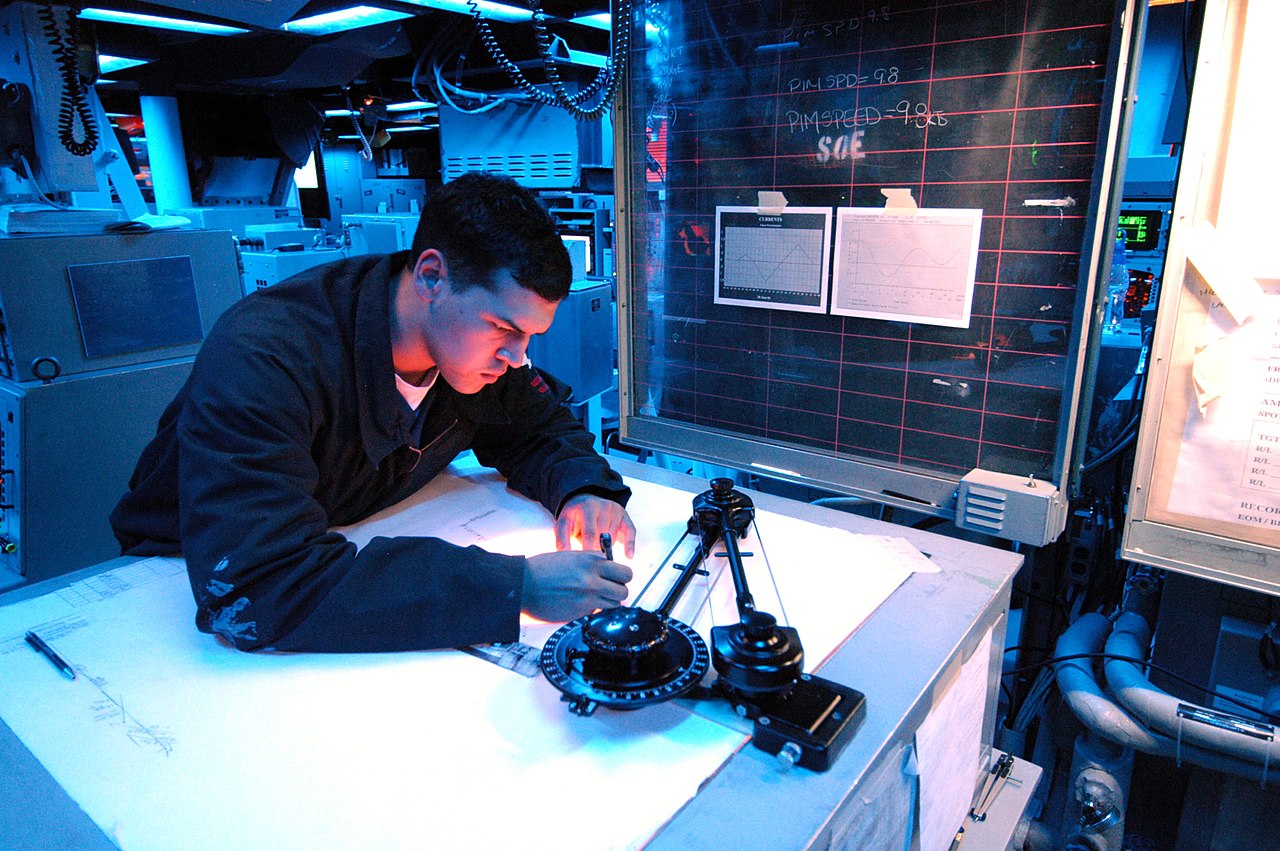
A sailor uses a Dead Reckoning Tracer
Plotting had first been introduced at Jutland, where it had given Jellicoe a decisive edge in positioning his fleet, despite problems with the implementation. During the interwar years, navies on both sides of the Atlantic worked out plotting techniques in exercises, added dedicated plotting spaces to their ships, and built automatic plotting tables which made an indication of the ship's location on a chart. The British maintained two separate plots, one for the strategic situation, and one for the immediate area around the ship in question. The Americans did not, and suffered in automatic plotting technology, too. The British used a device which projected a spot of light onto the map that moved based on the ship's indicated course and speed. The mechanical American Dead Reckoning Tracer tended to jump under the shock of gunfire. Plotting proved particularly vital in enabling night tactics, exemplified in the British victory at the Battle of Cape Matapan, where it gave them the confidence to avoid friendly fire and allowed them to take the Italians entirely by surprise.
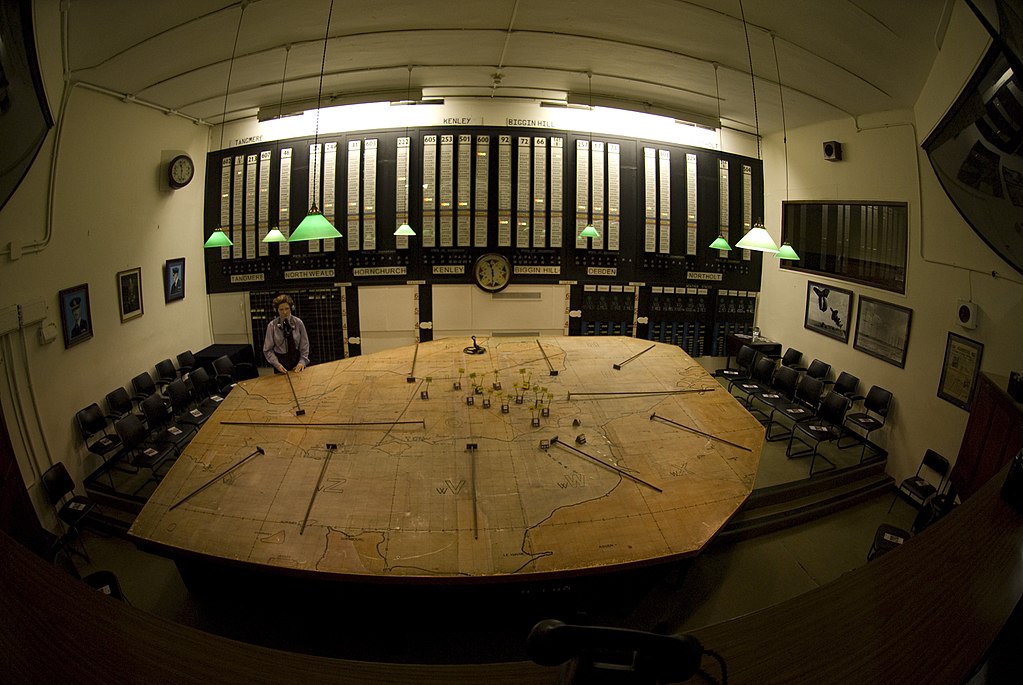
A plotting table from a Dowding System filter room
But it was obvious even before WWII that the real problem would be defense against air attack. The higher speed of aircraft necessitated that information be collected and used efficiently, and the first system to meet these requirements was the British Dowding System. It took data from the famous Chain Home radar, the reports of the Royal Observer Corps, and information from the Pip-squeak navigation/identification network, and passed them all through a massive "filter room" at Fighter Command HQ. These data points were then consolidated into tracks, with approximate strength, altitude, position, course and speed. These tracks were passed back down to regional operations centers, which used them to set up the actual fighter intercepts. This system took the percentage of fighters which saw targets from the 30% typical during the Battle of France to around 90%, and proved the key to defending Britain from the Blitz.
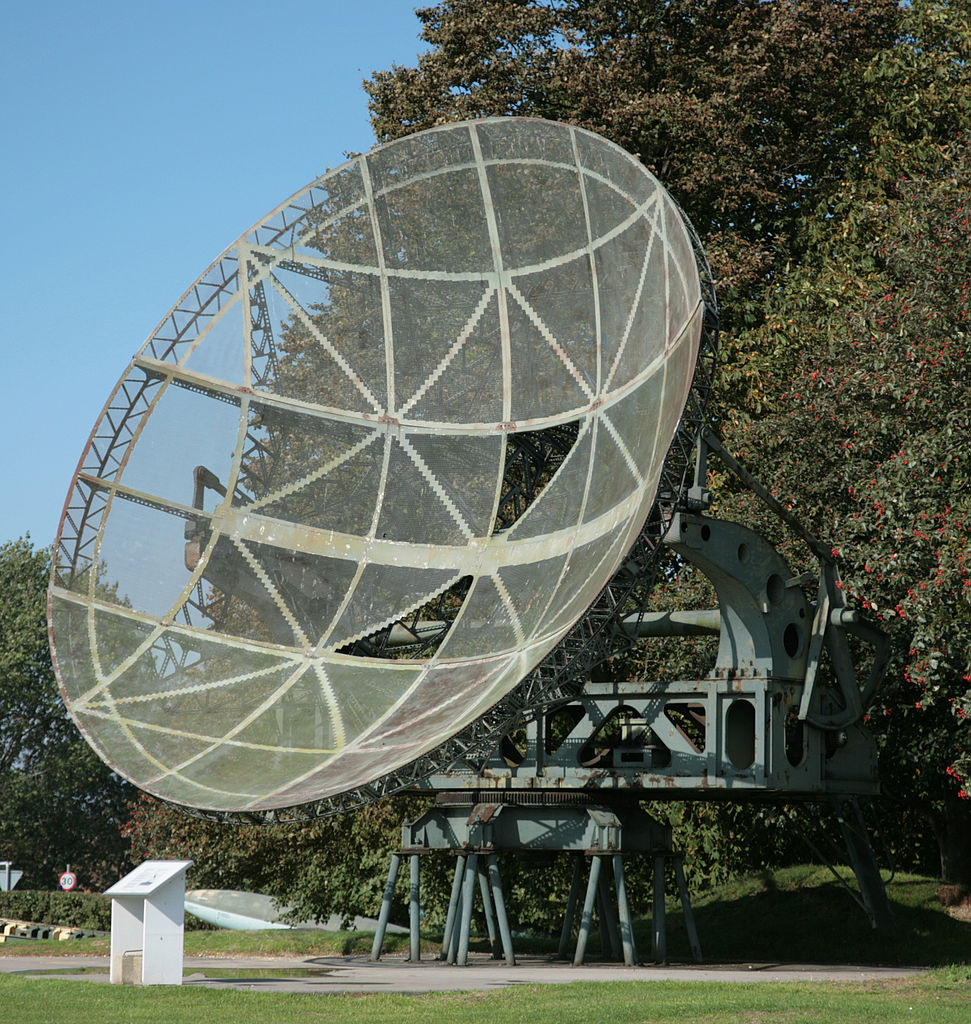
German Wurzburg radar
While this sounds straightforward and obvious, the Germans set up their radar defense in a totally different way. Their radars were actually more advanced, and they set up a series of cells, each with a single night fighter and a pair of radars. One radar would track the bomber, the other the fighter, and the ground controllers would coach the fighter to an intercept. This worked reasonably well, but each cell could only handle one target at a time. The British responded by routing all of their bombers to pass through the same few cells, saturating the system.1 The British system, while not immune to saturation, was significantly more robust, and it forms the foundation of every integrated air defense system in use today.
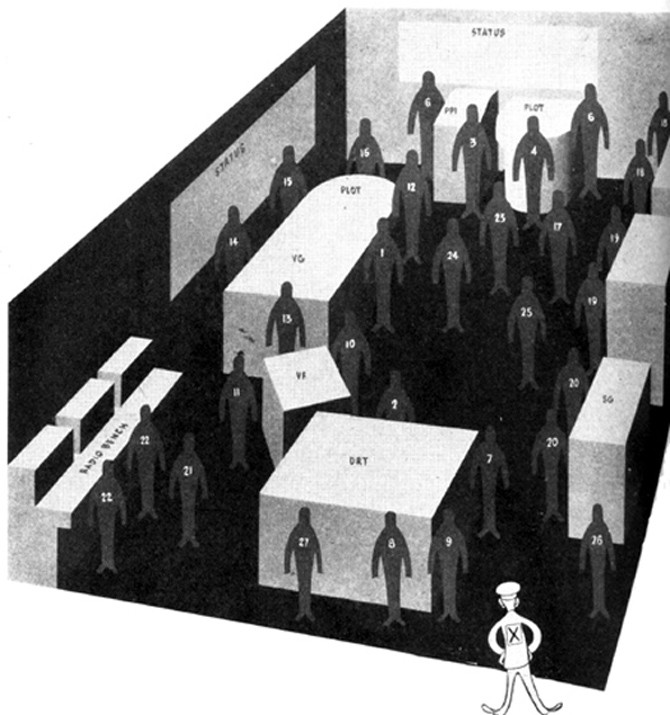
A diagram of a CIC. 1. Evaluator; 2. CIC officer; 3. Fighter director; 4. DR plotter; 5. Intercept plotter (by PPI); 6. Air status board keeper; 7. Geographic plot officer; 8. Geographic plotter; 9. Geographic recorder; 10. MB gunnery liaison officer; 11. Precision PPI operator; 12. AA gunnery liaison officer; 13. Surface plot officer; 14. Surface plotter; 15. Air plotter; 16. Assistant air plotter; 17. Radar supervisor; 18. SP operator; 19. SK operator; 20. SG operator; 21. Communication officer; 22. Radio recorder/operator; 23. JL talker; 24. JA talker; 25. JS talker; 26. JW talker; 27. Surface status board keeper
Taking this to sea was somewhat harder. While surface-search radar fitted smoothly into existing plots, air-search radar was somewhat harder to integrate, and the idea of combining tracks from multiple radars as the Dowding System did was out of the question. Between the need for radio silence, the limited bandwidth of existing radio links even when ships weren't being silent, and the problems of plotting tracks another ship reported, ships were initially limited to only working with their own data. However, this was still a massive improvement, and essentially the same techniques were used, with the men on the radar displays calling in tracks over audio circuits,2 which were then plotted by the crew in what was variously known as the Action Information Organization (AIO, British) or Combat Information Center (CIC, American).3 The CIC soon had several plots in it, usually one for the ship's navigation, another for keeping a summary of the surface situation, and a third for the air situation. In addition, radar repeaters, status boards, and men charged with running all of the equipment, evaluating the data, and communicating with the rest of the ship meant that these spaces were very crowded.4
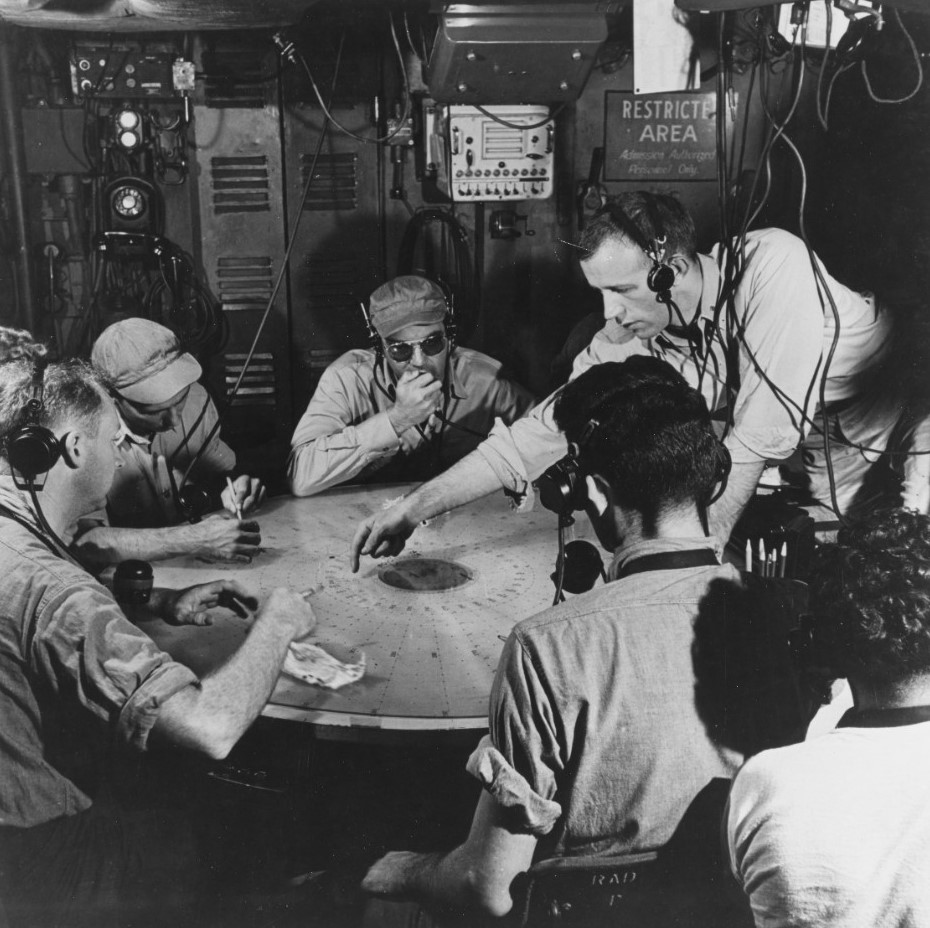
The plotting table aboard USS Lexington
The CIC was a revolution in warfare, making vastly better use of the information available to a commander than had been possible only a few years before. It allowed the US to develop viable night tactics and turn the tables on the Japanese cruisers in the South Pacific. Later, it allowed the US carriers to defeat the raids launched by their Japanese counterparts at the Battle of the Philippine Sea, despite the Japanese getting in the first strike. Under prewar conditions, that would have essentially guaranteed victory, but the Americans were able to intercept all of the raids well before the dive and torpedo bombers could reach their targets.

The CIC aboard Cassin Young.5
The CIC wasn't perfect, of course. A manual plotting system could only work so fast, and off Okinawa, the use of Kamikaze tactics6 allowed the Japanese to send in many small raids,7 saturating the CICs8 and allowing some attackers to slip through. This problem also occurred for AA guns, which were normally assigned by a CIC officer. The answer was decentralization. Picket destroyers were positioned to screen the fleet, each with a section of fighters under its control, while extra small directors were mounted on ships, and men on the bridges were given responsibility for designating targets. Postwar, the answer was to replace manual plotting with computers, a quest that we will cover next time.
WWII-era introduction to US CIC practices
1 The Germans in turn countered by decentralizing control of their fighters, often simply broadcasting the position of the bomber stream and letting the fighters plot their own intercepts. ⇑
2 During the first years of the war, radars were too heavy and too hot to place in the plotting spaces, and repeaters to allow remote viewing of the radar picture had yet to be developed. As repeaters entered service, they were placed in the CIC, and in some cases even fitted with screens that could have plots drawn directly on them. ⇑
3 Credit for development of this concept is often given to science fiction author E. E. "Doc" Smith in the form of the Directrix from his Lensman series published just before the war. This doesn't make much sense, given how much of the development was done in Britain, or at sea. This is a case of convergent evolution, and the quote usually used to support the attribution of the idea was based on a misunderstanding on the part of John Campbell, the famous SF editor. ⇑
4 One of the major differences between the CIC and the AIO was that the AIO usually occupied more than one room, with dedicated plots for air, surface, and overview, while the CIC didn't. US ships did have auxiliary CICs/plotting spaces, but they were definitely backups and not a splitting of roles. ⇑
5 My photo. Note the plotting board to the right, which is transparent. An operator plots on the board from behind. ⇑
6 Interestingly, by the end of the war, US air defenses were so good that kamikazes were actually more efficient in terms of lives and planes expended per hit than were conventional bombing attacks. This was primarily because the Kamikazes were so much more accurate, while the chances of a conventional bomber making it through fighters and AA guns and then escaping was low. ⇑
7 The reason this wasn't practical for conventional bombing was the need to saturate the point defense of the target. AA fire can drive off bombers, and so large numbers are needed to make sure that some can push through. Kamikazes usually steered for the heaviest concentration of AA fire. ⇑
8 Postwar tests showed that a CIC could handle about 12 raids an hour. ⇑

Comments
So I looked up that photo, and the Navy was still having guys plot dead reckoning positions on paper in 2004?
Is this a sort of navigation exercise so the kids can learn how bad grandad had it, or do they actually use it operationally?
CICs have always fascinated me, but you very rarely see explanations of them beyond some guy in a movie staring at a radar plot before telling a main character "sir, I think you'd better have a look at this."
I'm not really sure. Maybe they were. Maybe it was a good thing, and we saw the results of them stopping three years ago.
The serious answer is that a paper plot isn't vulnerable to power failures, and forcing people to stay in the loop reduces the chances of the kind of failures that happened with, say, Vincinnes.
And yes, CICs are definitely fascinating. They're also kind of a pain to write about, but I can announce that part 5 of this series is coming in about a month.
Warning, lots of memory usage ahead, but:
Paper plotting was the standard up until the late 00s/early 10s. USS SECONDSHIP changed over in roughly 2009, IIRC. There were ships using it later than that, and IIRC by 2013-14 or so they had stopped teaching the DRT at Surface Warfare Officer's School, and had introduced DDRT only. There were still people operating paper charts later than that (some FDNF-J ships may have been using them up until the middles of the 10s).
There were also specific evolutions that required you to use paper charts/DRT operations (NSFS is the big one, but some ASW evolutions, as well), if you didn't have a DDRT installed.
Note that we should probably separate out "Dead Reckoning" (a navigation technique) from manual plotting and/or navigation on paper charts, there's overlap in all of them.
Wow, thanks Blackshoe. I'd missed that reply until just now. It's a great answer as well as a ton of search prompts for finding out more.